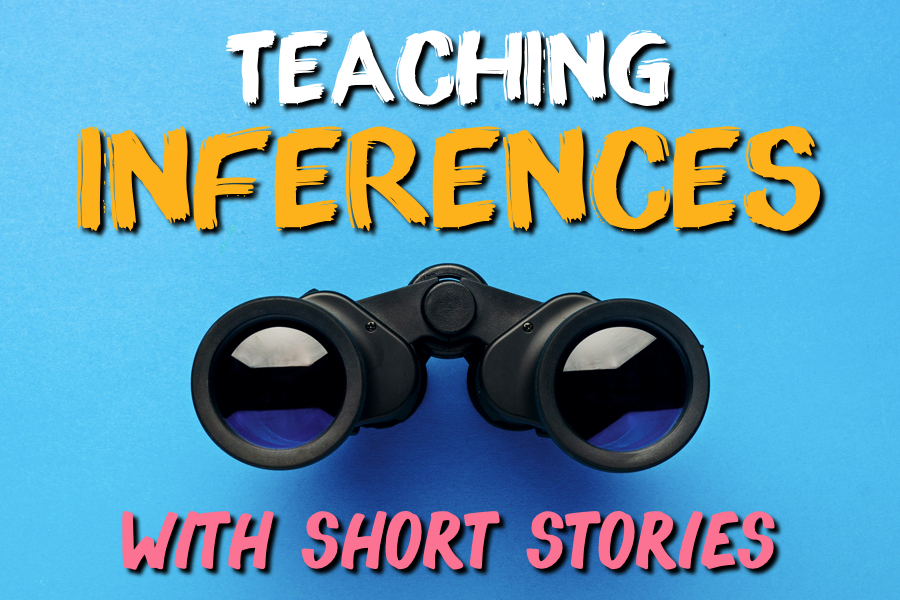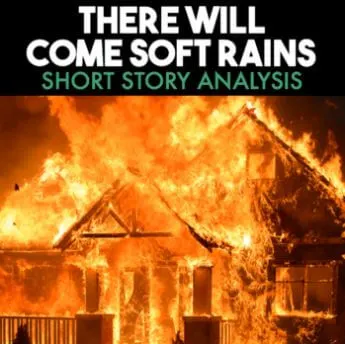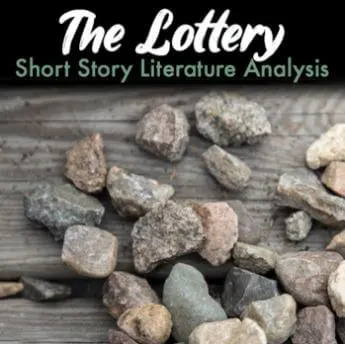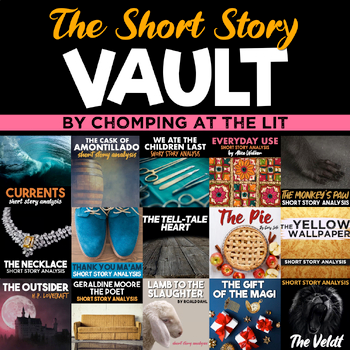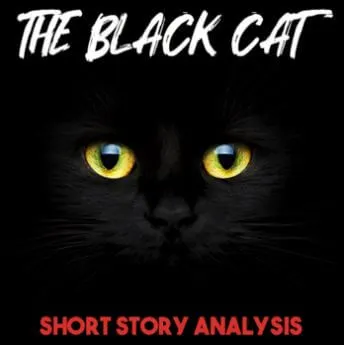Teaching inference is no easy task for teachers or students. However, short stories are the teaching tool you need to scaffold such an abstract concept. Learn the best tips and titles to bring to your classroom when teaching inference with short stories.
Teaching inference with short stories can completely change the game.
It’s a familiar scene: staring at a room of blank faces when we ask students a question that isn’t answered directly in the text. (Or maybe it’s just me…) Even at the secondary level, students struggle to learn abstract concepts and skills like inference. Truthfully, reading between the lines and drawing conclusions that rely on the implicit is challenging for many adults I know.
However, fear not! Short stories are a teacher’s best friend when teaching inference. Read on to find out why.
Why is Teaching Inference Important?
While students might know what inference is, that’s only part of the equation. We must also take a step back and explicitly teach how to make inferences. Therefore, we must be intentional with the tools and texts we use to make this abstract concept more concrete for our students. Explicitly teaching inference skills, and giving students the time and tools to practice them, is essential to student success in reading comprehension.
Overall, inference skills help students deepen their comprehension of a text. Inferencing helps students unpack characterization, determine themes, and analyze symbolism. Students rely on inferencing when making sense of plotlines, character relationships, and unresolved endings. The skill even comes in handy when students encounter unfamiliar vocabulary while reading. In other words, inference-making skills help pave the path to success for other literary skills and strategies.
Overall, inference skills help students bridge the gap between what’s explicitly on the page and what isn’t. Together, these explicit and implicit details paint the bigger picture. Therefore, once students can masterfully make inferences, they can strengthen their reading comprehension, make more meaningful connections, and deepen their analysis.
This evidence-backed bigger picture thinking is a skill your students will repeatedly use in the ELA classroom and beyond.
The Benefit of Teaching Inference with Short Stories
Considering how vital teaching inference is, you want to ensure you’re using the right tools and texts to teach it. While many students practice inferencing in their daily lives, the mere idea of applying this skill to literature can send students into a panic. Suddenly, it’s as if they have forgotten everything they know. However, teaching inference with short stories is the perfect stepping stone to unlocking their ability to understand and apply this essential skill in literature.
Since making inferences can be challenging for students, starting with shorter texts is a much more manageable ask. Often able to be read in a single sitting, short stories are the perfect length for students as they work to practice their inference-making skills. Additionally, they’ll be surprised with just how many inferences they can make in so few pages, showing that you don’t need much information to make meaningful inferences. Instead, you just need to know how to bridge the gap between what’s explicitly stated and what you already know.
The Best Short Stories for Teaching Inference
When choosing the best short stories for teaching inference, I recommend selecting high-interest stories. Students will be more eager to dive in and discuss their thoughts and interpretations. To save you time scrounging the web, here are a few of the best short stories for teaching inference:
1. “There Will Come Soft Rains” by Ray Bradbury
In this engaging short story, Bradbury takes readers on a journey of imagining a world where only technology remains. Between the main character, a fully automated home, and the post-apocalyptic setting, there is much for students to infer as they read.
As it turns out, there is a lot to read between the lines of this story. Students will have to read between the lines to determine what the descriptions reveal about the people who once occupied the home and the general society they lived in. Looking for an engaging discussion? Ask students to draw a conclusion about what they think happened to the family that once occupied the home and why.
2. “On the Sidewalk, Bleeding” by Evan Hunter
The title says it all when it comes to Hunter’s short story. There story literally takes place on a city sidewalk as 16-year-old Andy lies bleeding after being stabbed by a rival gang member. And it only gets more tragic from there.
Students are always stunned as they witness person after person neglecting to help the dying boy. To encourage their inferential skills, ask students to consider why no one offers a helping hand to the injured boy. While there are plenty of opportunities to make inferences throughout the text, this short story is an excellent springboard for discussing the assumptions we make about others we encounter in the real world.
3. “The Lottery” by Shirley Jackson
Jackson’s “The Lottery” is a horrifying tale about the dangers of blindly following tradition – and students absolutely love it. As students read, they begin to realize the titular lottery is not one you want to win.
Furthermore, as they pay attention to how various characters speak and act, they begin to put together pieces of the town’s history. As they put two and two together, students begin drawing conclusions about the roots of the town’s unsettling tradition and its impact on the townspeople.
4. “The Landlady” by Roah Dahl
Students will surely enjoy this highly engaging yet creepy short story. While a bit longer than many of the other short stories on this list, “The Landlady” is a great title to teach if you want your students to practice their inference-making skills.
Throughout the story, students have to make inference after inference to make sense of the sinister plot. Between the setting and characterization, many details imply something is off about the bed-and-breakfast and its owner. After reading the shocking ending, students will be eager to go back and search for “warning signs” of the eerie ending to come.
5. “So What Are You Anyway” by Lawrence Hill
Lawrence Hill’s “So What Are You Anyways” is a great resource for students to practice making inferences. The story follows a young girl named Carole as she faces an awkward encounter with the couple seated next to her on an airplane. Through this interaction, Hill tells an enlightening tale about the socially constructed notions of race, a message students should be able to piece together by the story’s end.
Many students quickly pick up on the rude, intrusive, and arrogant nature of Henry Norton in contrast to Carole’s innocence, despite these traits never being explicitly stated. Therefore, it’s a perfect opportunity to build their confidence around their ability to make inferences. (Yay!) But don’t stop there. There’s much to unpack and infer when reading the uncomfortable interaction between characters.
6. “The Black Cat” by Edgar Allan Poe
From the first lines of Poe’s “The Black Cat,” students can infer that the narrator is crumbling under immense guilt. The story begins with the narrator swearing by his sanity before recounting his terrible actions and haunting superstitions. However, as students continue to read, they quickly realize the narrator’s actions and dwindling mental state imply otherwise.
Students can practice their inference-making skills as they track hints of the narrator’s haunting superstitions and growing guilt. Furthermore, there is much to unpack about his relationship with the titular (and slightly eerie) black cat. Trust me when I say students will have a field day with this one.
Honorable mentions: If you’re looking to start with something a little lighter, both “Main Street” by Jaqueline Woodson and “Flying Lessons” by Soman Chainani are excellent titles for younger middle-grade readers.
Guiding Reading for Teaching Inference with Short Stories
Help students hone their focus on inference-making skills by doing guided reading. Instead of having them dive in head first, scaffold their learning and skill application with the right questions. Conduct guided reading as a whole class or use questions, graphic organizers, and engaging activities with smaller guided reading groups.
Consider guiding students with the following questions:
- What question are you trying to answer?
- What do you want or need to know to answer it?
- What do you already know that can help you draw a conclusion?
- What additional clues or information does the author/text provide to help?
- How does this information support your inference?
These questions are a great way to scaffold students learning and guide them toward success. Eventually, they’ll be able to make inferences all on their own!
More Tips for Teaching Inference with Short Stories
- Make it relatable. Remind students that they are making inferences all the time. Spend time discussing real-life scenarios where students make inferences, such as making assumptions when meeting someone new or scrolling on social media.
- Teach showing vs. telling. Show students the power of showing vs. telling and how it can be a crucial component of inferential thinking. Engage students in creative writing prompts, like describing an emotion without explicitly stating it, to help them understand how authors use descriptive writing to convey everything from character emotions to deeper messages in a creative, more meaningful way.
- Encourage the use of evidence. Encourage students to back up their inferences by pointing to specifics in the text that led them to that thought or conclusion. Adding this step requires them to sloooow down and make intentional inferences. It also drives home the idea that inferring requires you to rely on explicit and implicit information. Whether it’s in writing or during a discussion, ask students to explain the reasoning behind their conclusions. Have them cite textual evidence where necessary.
- Engage students in meaningful discussion. One of the best things about inferences is that there isn’t always one right answer. However, this can always be hard for students who need that reassurance. Therefore, leave time for discussing students’ inferences about a text, showcasing that there are multiple ways to interpret a text as long as you can back it up with evidence and reasoning.
When it comes to teaching inference, starting small is your best bet. That’s why I recommend teaching inference with short stories. Not only will it set students up for success, but there are many short stories rich with opportunities for inferences that students find enjoyable and engaging. Before you know it, your students will be ready to apply their knowledge to longer, more complex texts.
So, give these titles and teaching tips a try! And, while you’re at it, be sure to check out my other posts about using short stories to teach theme, characterization, and plot.
